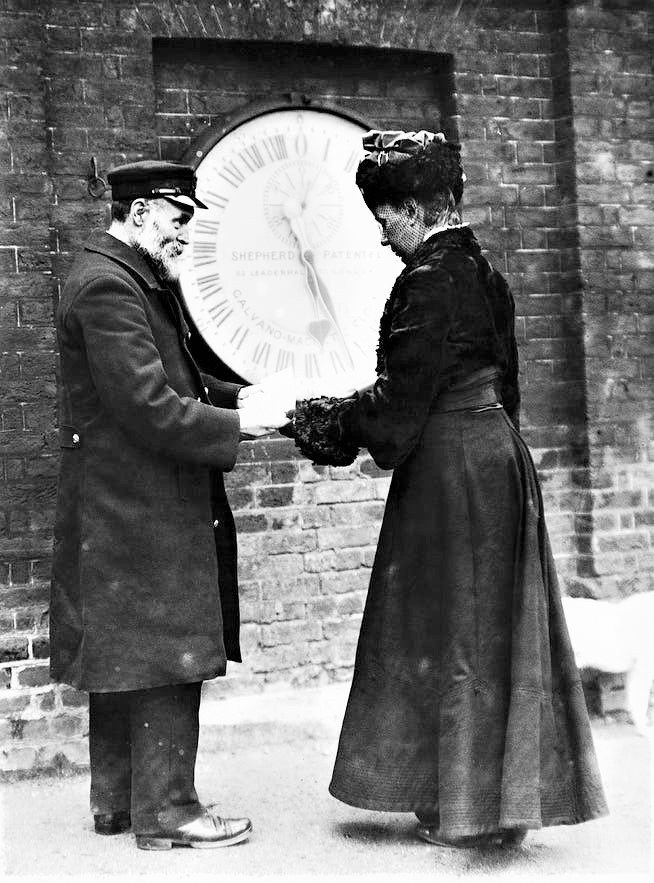Mechanical clocks of the 19th century and earlier were not very accurate timekeepers and tended to drift over the course of a single day. After a few days, these clocks could no longer reliably tell time. Then, the clocks had to be calibrated, usually by clockmakers.
One source of accurate time were observatories. An astronomer with a telescope could tell the precise time by looking at the sun and the stars in the sky. This time was then relayed to the public and to ships using audio-visual cues, such as firing a gun or raising a flag.
The time ball atop Flamsteed House at Greenwich, London. Photo credit: Carmen Seaby/Flickr
The Royal Observatory in Greenwich was the primary keeper of time. To help mariners at the port and others in line of sight of the observatory to synchronize their clocks to the Greenwich Mean Time, the observatory had a very visible time ball that dropped precisely at 1 pm every day atop the observatory. It still does. Later, the observatory installed a large clock on its gate so that anyone could see the accurate time at any moment rather than wait for a signal. However, to view this clock, people had to physically make a trip from their homes and offices across London to the observatory, which was inconvenient.
John Belville, an assistant at the Royal Observatory, had a plan. Rather than having people come to the observatory, have the time go to the people. Everyday, Belville would set the time on a pocket watch at the observatory, then travel around London passing out the accurate time for a small subscription fee. Belville had around two hundred clients consisting of the railways, clockmakers, ship chartering companies and rich individuals who wanted to ensure their watches were tracking the right time.

The Belville family’s pocket watch, ‘Arnold’, at the Clockmakers’ Museum. Photo: Science Museum
The watch Belville used was a state-of-the-art John Arnold pocket chronometer that provided time to an accuracy of a tenth of a second. It was originally made for the Duke of Sussex and had a gold case. When it was given to John Henry, he changed the case to silver because he was worried thieves might steal a gold watch.
John Henry continued this service until his death in 1856, upon which his widow, Maria, was granted the privilege of carrying on the work as a means of livelihood and continued the business until her retirement in 1892 when she was in her eighties. Maria then passed the family business to her daughter Ruth.
Related: The Pneumatic Clocks of Paris
When Ruth Belville took over the business, she faced stiff competition from different telegraph time services that were capable of signaling time by telegraph system. If you had the right equipment, you could automatically synchronized your clocks using time signals transmitted directly from various observatories. But homes and small businesses didn't have in-house telegraph stations. So they continued to rely on Ruth Belville.

Maria Belville, mother of Ruth Belville, 1892.

Ruth Belville at the Royal Greenwich Observatory, 1908.
John Wynne, the director of the largest company devoted to distributing time signals telegraphically, even attacked Ruth Belville publicly, claiming “that her methods were amusingly out of date”. He also implied that she “might have been using her femininity to gain business.”
After his speech was published in The Times newspaper Belville was besieged by reporters interested in her business and also the possible scandal, which was implied by Wynne's comments. Belville managed to cope, and the resulting publicity resulted in an increase in sales. Belville said that all Wynne had managed to do was to give her free advertising.
Like her mother, Ruth Belville continued selling time until her eighties, when she retired in 1940. By then, modern technologies had outpaced Ruth’s beloved pocket watch and it could no longer compete with more efficient, reliable and accessible modes of communication. In all, the Belville family business spanned 104 years, from 1836 to 1940.
Before Ruth passed away in 1943, she donated her watch, nicknamed “Arnold”, to the London Clockmakers' Company. It is now housed at the Clockmakers’ Museum in London.













Comments
Post a Comment